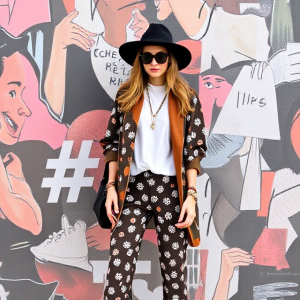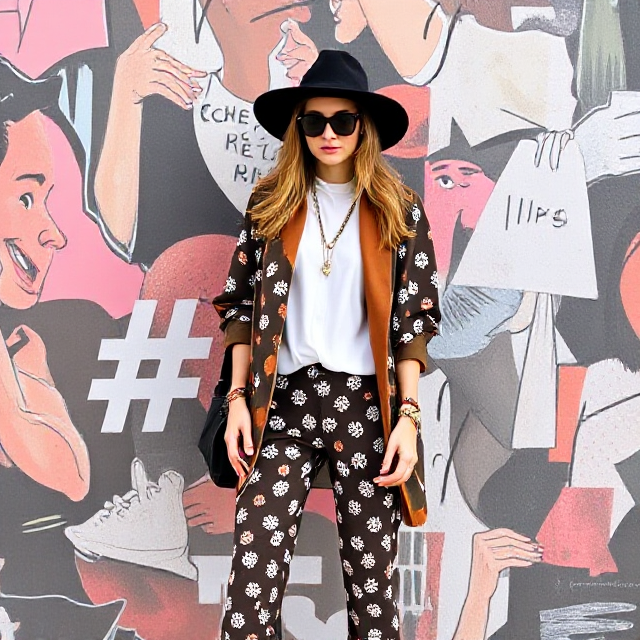
Social media has become a major platform for promoting fashion brands, sharing personal style, and connecting with audiences. A key component of this social media success is the effective use of hashtags. Hashtags not only help in organizing content but also make it discoverable to a larger audience. Fashion hashtags, when used strategically, can significantly boost engagement, increase visibility, and help brands or influencers reach their target audience. Below is a comprehensive guide on how to create and execute an effective fashion hashtag strategy.
Understanding Hashtags in Fashion
Hashtags are words or phrases prefixed with the “#” symbol, designed to categorize and organize content, making it easier for users to find specific topics or trends. In fashion, hashtags play a crucial role in connecting posts with people who are interested in particular styles, trends, or brands. They allow users to discover content beyond their immediate social circles and help influencers, brands, and consumers become part of the larger fashion conversation.
The Importance of Hashtags in Fashion Marketing
- Increased Reach and Visibility: Hashtags make your content discoverable to people who follow or search for them. A relevant, trending hashtag can exponentially increase the chances of your content reaching users who are not already following you.
- Community Building: Hashtags create a community around certain interests. Fashion brands or influencers can develop their own branded hashtags, allowing users to engage with them directly, share content, and become a part of the brand’s identity.
- Targeted Marketing: By using niche-specific hashtags, fashion businesses can target specific audiences interested in particular styles, trends, or products. This can be particularly useful for driving conversions and connecting with potential customers.
- Participation in Trends: Fashion is dynamic, and trends change rapidly. By using trending hashtags, users can participate in global conversations, elevate their content, and increase engagement with a broader audience.
Key Elements of a Successful Fashion Hashtag Strategy
To maximize the effectiveness of hashtags in fashion, it’s essential to create a balanced strategy that includes a mix of popular, niche, and branded hashtags. Below are the core elements to keep in mind when planning your fashion hashtag strategy:
1. Research Popular and Relevant Hashtags
It’s important to stay on top of trending and popular fashion hashtags. This can include seasonal trends, fashion weeks, designer collections, and events. Trending hashtags can give you a significant boost in visibility if they are relevant to your content. For example, during Fashion Week, hashtags like #NYFW or #ParisFashionWeek may attract a lot of attention.
Tools for Research:
- Instagram’s Explore Page: By exploring Instagram’s trending page, you can see which fashion-related hashtags are gaining traction.
- Hashtag Generator Tools: Platforms like All Hashtag and Hashtagify can help you identify popular hashtags related to fashion.
- Competitor Analysis: Look at what successful fashion brands or influencers are using to stay relevant.
2. Leverage Niche Hashtags
While general, high-traffic hashtags can give you broad visibility, they can also be competitive. Niche hashtags are less saturated, offering a higher chance of getting noticed within a specific community. Niche hashtags could be related to a particular style, like #StreetStyle, or a demographic, like #PlusSizeFashion.
Using niche hashtags helps target users with specific interests and leads to a more engaged audience. For example, #VintageFashion, #EcoFashion, or #MenswearDaily can attract users interested in those specific topics, helping you establish a more loyal following.
3. Create Branded Hashtags
Branded hashtags are unique to your brand or campaign. They are used to build a sense of community around your fashion label or personal brand and encourage user-generated content (UGC). For instance, Nike might use a hashtag like #JustDoIt, encouraging fans to post their own images featuring the brand’s products.
When creating a branded hashtag, keep it simple, memorable, and relevant to your brand. Make sure it’s short enough for users to easily type, and check if it’s available across platforms.
How to Encourage UGC with Branded Hashtags:
- Contests or Giveaways: Run campaigns where followers need to use your branded hashtag to participate.
- Highlight User Content: Share posts from your followers using your branded hashtag, which will encourage more users to participate.
- Collaborations and Partnerships: Partner with influencers and ask them to use your branded hashtag to extend its reach.
4. Use a Mix of Hashtag Categories
An effective strategy involves using a combination of different types of hashtags. These can be grouped into the following categories:
- Broad Hashtags: These are popular, widely used hashtags that bring high visibility but are also highly competitive. Examples: #Fashion, #Style, #OOTD (Outfit of the Day).
- Moderate Hashtags: These hashtags are specific to particular topics or niches and are used by many but not as much as the broad ones. Examples: #SustainableFashion, #Menswear, #BohoStyle.
- Niche Hashtags: These are highly specific hashtags that often have a smaller but more engaged audience. Examples: #IndieFashion, #CurvyFashion, #90sFashion.
Using a mix ensures that you strike a balance between reaching a large audience and targeting a more engaged, specific group of users.
5. Stay Updated with Fashion Trends
Fashion trends change quickly, so staying up-to-date with the latest shifts is key to maintaining an effective hashtag strategy. Following fashion blogs, industry news, and keeping an eye on social media trends will help you stay ahead of the curve.
Platforms like TikTok and Instagram are particularly good at showcasing emerging trends in the fashion world. Hashtags like #Y2K, #Cottagecore, and #Athleisure are examples of trends that can drive engagement when used correctly.
6. Limit the Number of Hashtags
While it might be tempting to use as many hashtags as possible, research shows that using too many hashtags can actually reduce engagement. Instagram, for example, allows up to 30 hashtags, but studies suggest that using between 5 to 10 hashtags per post is optimal for engagement.
Keep your hashtags relevant and aligned with your content. Too many irrelevant or excessive hashtags can make your post appear spammy, diminishing the user experience.
Best Practices for Using Fashion Hashtags
- Avoid Overused or Spammy Hashtags: Using overly generic hashtags like #Love or #InstaFashion can hurt your visibility. These hashtags are often oversaturated and can reduce your chances of being seen. Opt for hashtags that have a meaningful connection to your content.
- Track Performance: Use Instagram Insights, Twitter Analytics, or other social media monitoring tools to track the performance of your hashtags. By assessing which hashtags lead to the highest engagement and conversions, you can continuously refine your strategy.
- Keep It Simple and Clear: Your hashtags should be easy to read and understand. Avoid over-complicating or over-using special characters, and make sure your audience can easily interpret them.
- Stay Consistent: Consistency is key. By using the same set of relevant hashtags, your audience will start associating certain terms with your content. This is particularly important when using branded hashtags.
- Create Hashtags for Specific Campaigns: During a product launch or special event, consider creating unique hashtags that are specific to that campaign. This can help you consolidate all content related to the event or launch and track its success.
Hashtags are a powerful tool in the fashion industry, enabling brands, influencers, and consumers to increase their visibility, reach the right audience, and build a sense of community. By combining trending, niche, and branded hashtags and staying on top of the latest trends, you can execute a winning hashtag strategy that amplifies your fashion content, enhances engagement, and helps you connect with your target market. Remember, the key to success lies in balance: use hashtags that are relevant, strategic, and aligned with your brand’s identity.
